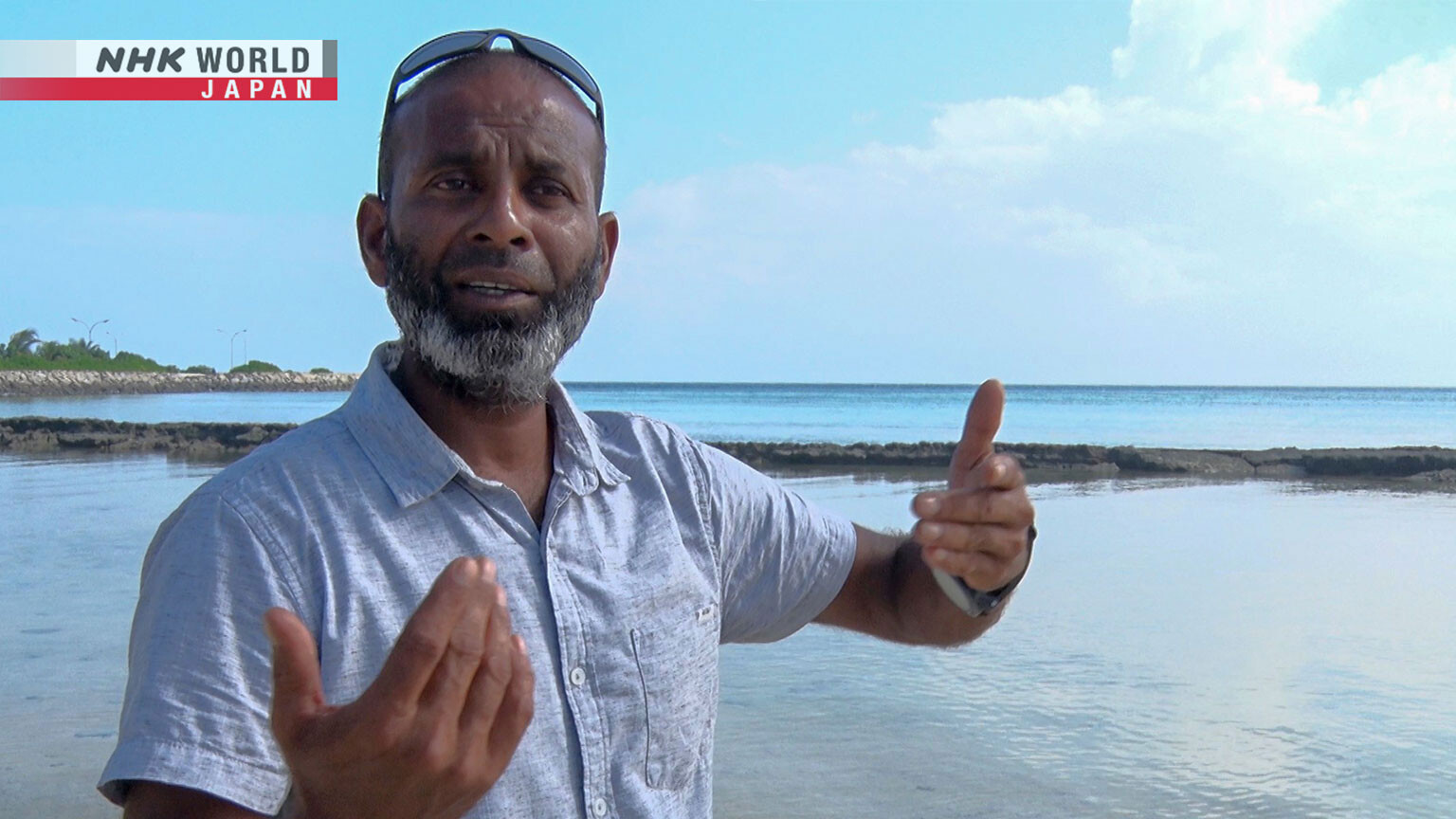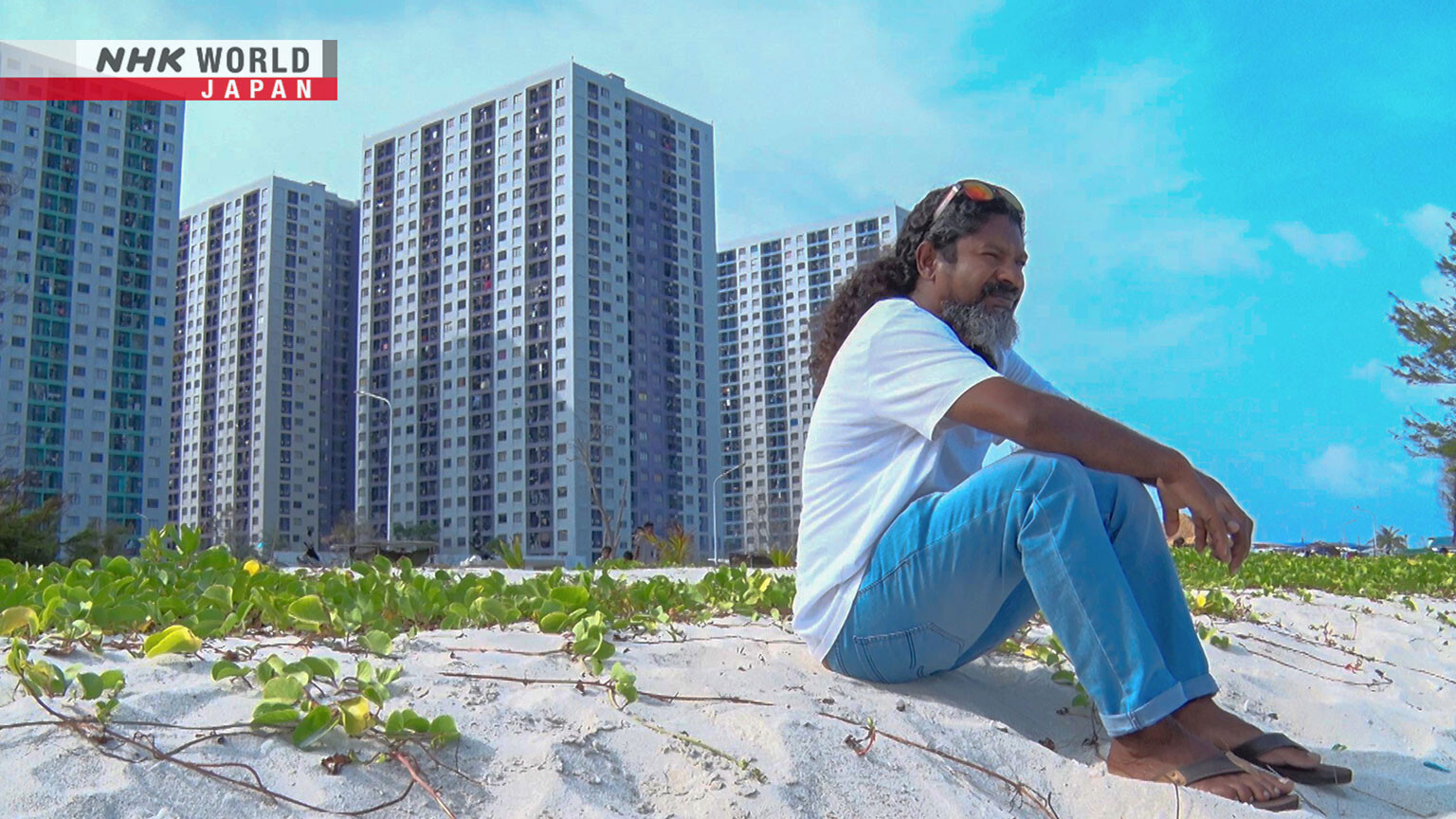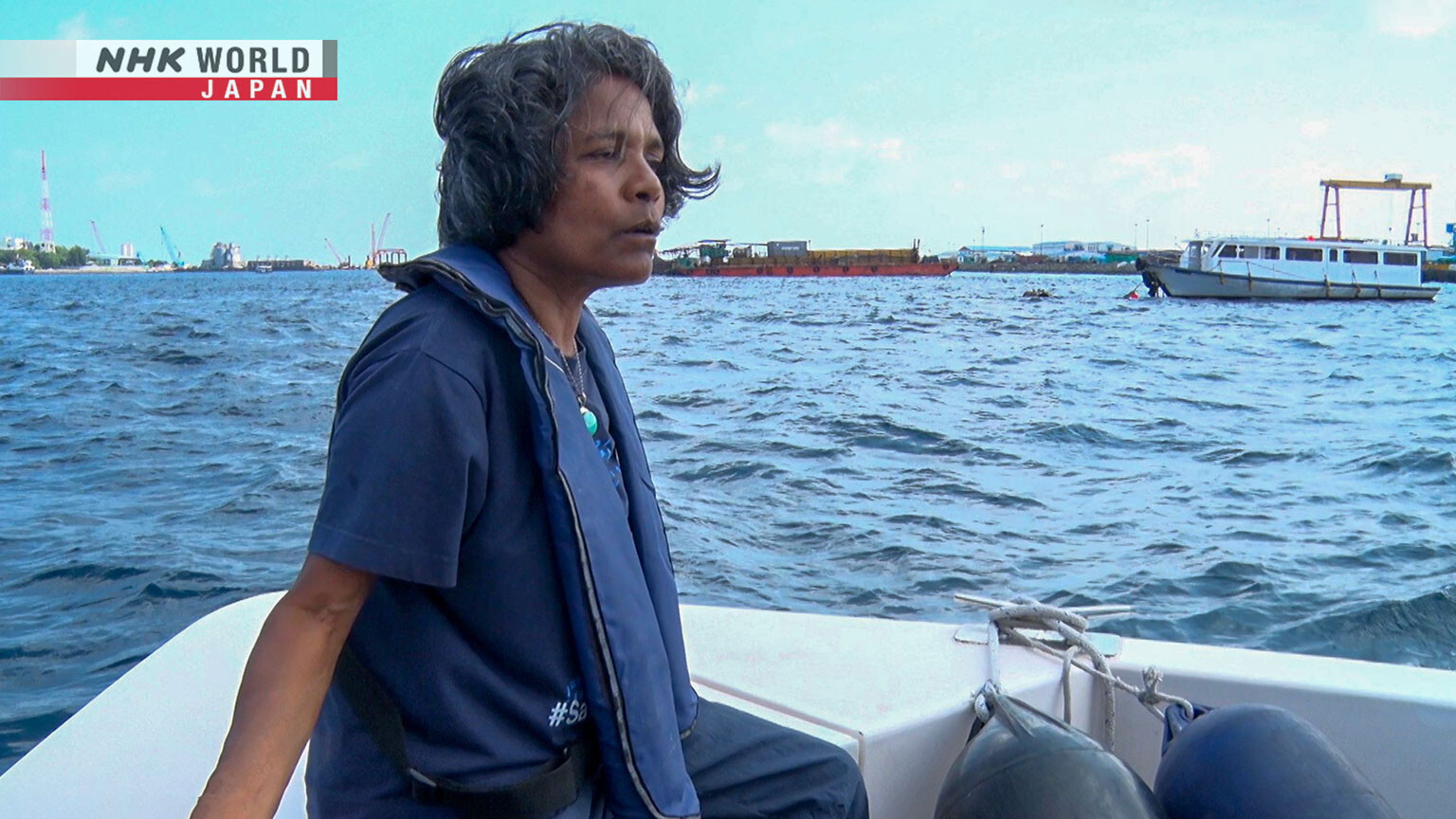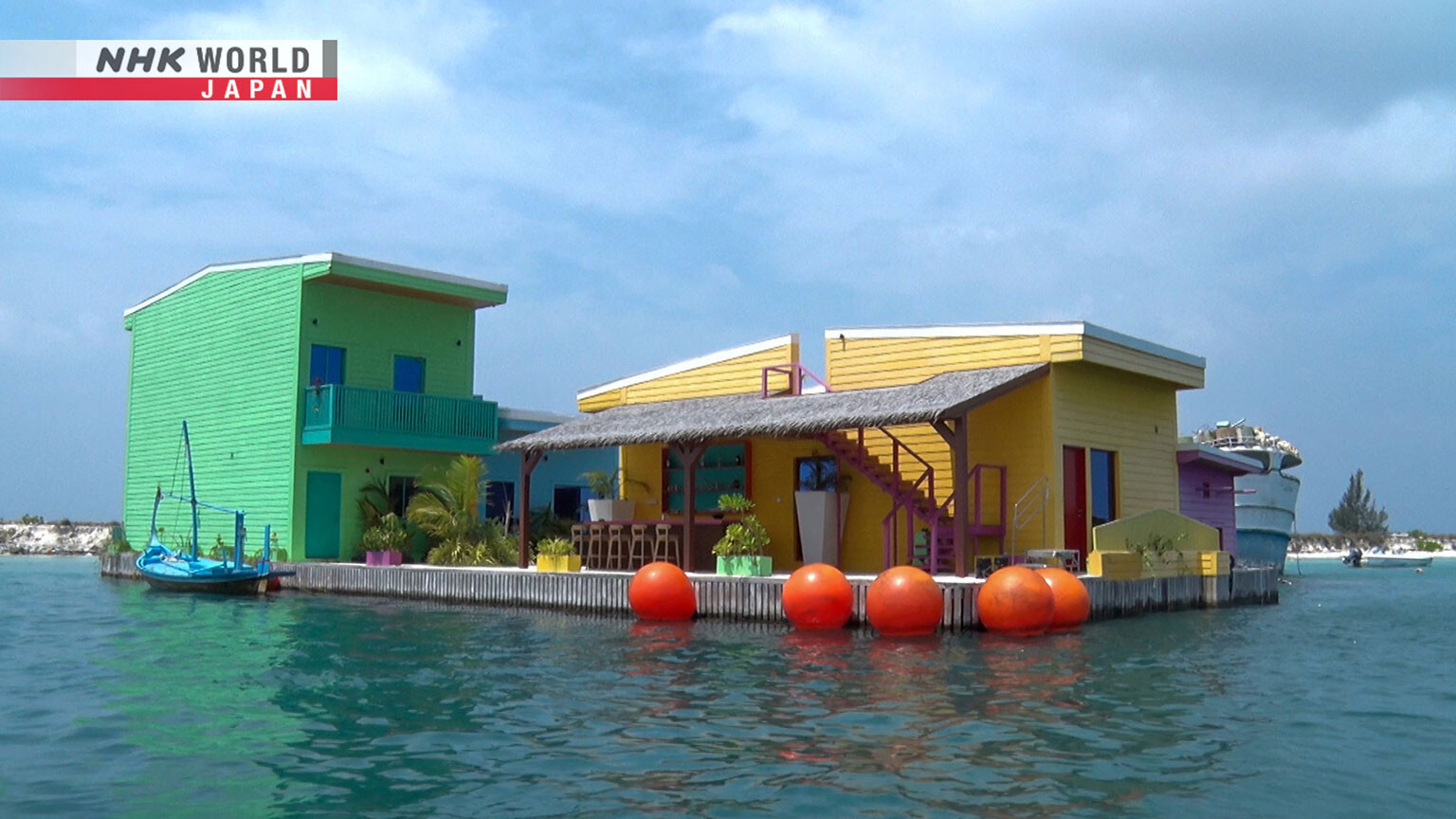Living Among the Sinking Islands: The Maldives
In the Maldives, rapid construction of artificial islands is underway to combat coastal erosion that disrupts the lives of people near the shore, but with the construction come new difficulties.




Transcript
Made up of some 1,200 islands in the Indian Ocean is Asia's smallest country, the Maldives.
Its beautiful waters attract many visitors, but the country is in the midst of a sea change.
All islands are slowly being inundated by the sea one by one.
If we do not reverse this trend the Maldives will cease to exist.
According to the Intergovernmental Panel on Climate Change,
by the year 2100 the world's average sea levels may rise by as much as 1 meter.
80% of the land in the Maldives is 1 meter or less above sea level.
Erosion can already be seen eating away at low-elevation islands.
I used to live in my dream home.
Why do the waves come in so strong?
As one countermeasure, the government has begun constructing artificial islands.
These landmasses create residential areas at higher elevation, but with them come other challenges.
I hardly have any friends here.
I miss the old island.
This is sediment.
This is what kills the coral.
What difficulties are faced by these slowly eroding islands?
In this episode, we meet the people of the Maldives.
Himandhoo is an island 90 km west of the Maldives' capital of Male.
Its population numbers around 900.
Most people work in the tourism or fishing industries.
Iqbal Bilal makes his living as a diving instructor on the island.
These are photos of this week's dive.
I give them to the participants as a souvenir.
Bilal recently moved inland, away from the ocean.
He says that the choice was inevitable.
My mother asked me to come live here.
It's been three months since the move.
I used to live in my dream home.
I have no idea if I can go back.
He once lived right beside the ocean.
This is my previous house.
It's the dry season now, so things won't get any worse.
I've seen flooding in the rainy season.
Four years ago, he built this house with his hard-earned savings.
But it didn't take long for him to notice a change.
The water reaches this far, but it used to be sand here.
It went all the way to that coral.
When I built my home, I had no idea this could happen.
He shows us a video he took during the previous year's rainy season.
The waves reach the very edge of his property.
I wanted to build here because of how beautiful the landscape is.
But the land is being eaten away right before my eyes.
They're too much for a normal seawall.
Why do the waves come in so strong?
With the ocean lapping at his feet, Bilal began to fear for his safety,
and was forced to give up the oceanside life.
He had made every effort to preserve his dwelling before the move.
I built this all along the way, using cement and coral.
To defend his home from the encroaching waves, he constructed a makeshift barrier.
He's managed to keep the house standing, for the time being.
The municipal council is also struggling with the rising waters from coastal erosion.
The erosion has eaten away at this shipbuilding site.
It affects all of the islands around here, but Himandhoo has it really bad.
At high tide, the waves come this far in.
Seawall construction has become a necessity.
To effectively shield the area, the council estimates costs of over 300,000 US dollars.
It's a tall order for the small island of Himandhoo.
Our council only has access to a budget of around $65,000.
The erosion problem is so major that we can't handle it all ourselves.
We need the national government's help with major construction.
Even after requesting government aid, assistance isn't forthcoming.
Government action comes down to things like political connections and population.
We don't have a lot of people here.
Our port construction was also given low priority.
90% of the other islands come first.
We'll keep requesting help from the government all the same.
At the same time, certain islands are making greater progress against the erosion.
Male Island, the location of the capital of the Maldives.
Around the 6 km circumference of the island, wave-dissipating blocks and seawalls have been constructed.
Male has 40% of the nation's population, around 200,000 people.
As citizens seek work and education, these numbers are steadily increasing.
In order to accommodate them, artificial islands are being constructed around Male.
The projects address both urban overpopulation and future water-level concerns.
Hulhumale is the largest among the manmade islands.
Mohamed Shan works at a clothing store on Hulhumale.
In June of 2023, he and his family moved here from an island 30 km away.
I live on the 24th floor of that building.
60,000 people now live on Hulhumale.
Construction of the island began in 1997.
Its average elevation is 2 m above sea level.
It's nice here. There's a brisk wind and a fine view.
There was erosion where I lived before.
Hulhumale is much safer than that island.
Let's eat.
Before moving, Shan made his living as a fisherman.
Concerns over the erosion and his children's education motivated the decision to move.
His family's life has improved in both regards.
The schools here offer a range of subjects.
There's the opportunity for high-level study, like attending college.
The waves are a little rough today.
It makes me miss the old island.
Shan's new life separated him from the hometown where he'd lived for 40 years,
and some aspects are challenging to him.
Our finances are hard.
Rent is $780.
With utilities, $1,170.
There's no room for savings.
It's sure tough to get by.
Shan's earnings from the clothing shop barely sustain them.
Unfortunately, his misgivings don't end there.
I used to know everyone on the island.
I hardly have any friends here.
You don't know anyone nearby?
Just one person.
I'll live here until my children finish their educations.
After that, I don't plan to stay.
With the increasing number of relocations, a new problem arising is the loss of community.
One researcher believes that it affects the safety of those living on the artificial islands.
Aisha Azfa explains the issue.
What we are seeing right now is that it's very individual.
And when you buy a house or an apartment in Hulhumale, you only live in that house.
You do not even know your immediate neighbor or the people who is living in your building.
So in the case if there's a disaster, if there's another tsunami,
what kind of you know, we do not know what will happen.
Azfa considers it vital that artificial island residents feel a sense of unity.
In a small island, that's one of the main things that you have going when you know your neighbors.
For example, If there's something happening, um, in a small community,
it is in our culture that if you are sick, for example, the community will come and take care of you.
Even during the tsunami, they were they, they stuck together and they helped each other so much.
So that kind of community, you know, sense of community becomes a very important part in your everyday life.
So that that is why I tend to think about that kind of social capital,
that kind of, um, connections that's so important for, for our survival and our safety and our resilience.
The problems caused by artificial island development extend beyond social issues, to the ecosystem.
Since 2017, Humay Abdulghafoor has organized social activism opposing land reclamation projects.
She conveys environmental destruction and the associated risks through her website and social media.
It looks like they are offloading, uh, material.
Looks like aggregate.
Um, so maybe it is, uh, for the revetement work.
That's what it looks like to me.
She has taken notice of an island currently under construction.
Gulhifalhu Island is 4 km west of Male.
It has an area of 192 hectares.
On this manmade island the size of 270 soccer fields,
plans to build apartment buildings and ports are underway.
So altogether, uh, they plan to use, um, 24,500,000m³ of sand.
The sand for the island is being dug from the surrounding ocean floor.
Yeah, this is something they've created. This is not shallow water.
This is sediment. This is sediment.
Oh, wow. So it must be dredging now.
So, while it's, while it's dredging, it leaves this massive trail.
And this is what kills the coral.
Uh, they cannot contain this sediment.
They cannot control the damage they cause.
Abdulghafoor describes how the sediment dredged up in construction coats the coral reefs,
impeding their supply of oxygen and nutrients.
I just want the reclamation to stop because the reclamation itself is continuing to damage the whole area here.
It's not just this particular point that is being destroyed.
It is affecting the whole area.
The effects of the dredging apply not only to the reefs,
but also to the residents of surrounding islands.
Villimale Island is home to 7,000 people.
Located nearby Gulhifalhu, it's only 1 km from the dredging site.
With the sediment clouding the waters, there are no good diving spots anymore.
We used to dive around here, but now it's only good for training.
There used to be a number of fishing spots around the island.
They're all gone now.
It's expensive having to travel so far by boat.
Abdulghafoor believes that the environmental inspection prior to construction was fundamentally lacking.
They did the environmental impact assessment for the Gulhifalhu land reclamation project in April 2020.
But, this EIA does not value the existing resource use.
In the case of the Addu reclamation project,
the value of damage to 21 hectares of coral reef will be about US dollars 343 to 858 million.
When an island is constructed in the ocean,
the Maldives normally requires that a report be made on the projected environmental impact.
The report for Addu Island specified the value of natural resources lost in development,
but no such valuation was made for Gulhifalhu.
Abdulghafoor emphasizes the importance of making the proper inspections for all construction.
Because, how do they know that the benefit of the project is going to outweigh the losses?
So there is no cost-benefit assessment of the environmental loss.
Reclamation is very easy.
They can do it in, you know, a few months.
The destruction that the Maldives is doing to our islands, the Government of Maldives is doing to our islands is a bigger threat.
Uh, to our islands and our ability to live here than sea level rise at this point.
Meanwhile, a new construction model has emerged that reduces the burden placed on the environment.
Okay, so this is the model we have created to show how it looks like.
Here we see a street.
Typically this is the street where we have the sand so that community can enjoy it.
This collaboration between the Maldives government and a Dutch company is called the Maldives Floating City.
6 km northwest of Male, 5000 homes are planed to be built atop 2 square km of the ocean's surface.
If we reclaim, it's not very good for the environment.
So instead of doing that, the idea is to actually to have floating platforms with housing on it.
They're making a neighborhood of homes connected to pillars rooted in the ocean floor.
Since it avoids the ground reclamation,
the project intends to reduce the strain on the environment and bypass the effects of rising water levels.
Special measures have been taken with the home design.
Now this is the street view here.
So the, the this the people living in this house can see the street side or either see the side.
So this is the advantage of the floating city.
Unlike the apartments that are in the building, every house has this access.
And you have access to the balcony.
So from here you could see the street view, you could talk to the community.
And this is this is the lifestyle we want to introduce.
All of the homes have been positioned to border the street.
The concept is meant to improve communication between residents, and build a neighborhood with a sense of unity.
I think, uh, I am a citizen of Maldives.
I have seen the change.
We don't see neighbors.
We don't know where they are.
So this project will bring back the life we lived, we want to live.
The project will begin in May of 2024, and aims for completion within 5 years.
The price of the homes is more than 15 times the average yearly income in the Maldives.
Whether it will become a new standard remains to be seen.
This house is the starting price is $250,000.
That is typically still better than the luxury apartments in the Maldives.
Once we do the first city, the cost of doing the smaller scale one will be cheaper.
Then we will already have the setup, the know-how, everything is there.
So this may be a little bit expensive.
The second project will be much cheaper.
Himandhoo, the island being eaten away by progressive erosion.
Diving instructor Bilal sits down to share a meal with his friends.
I tried diving for the first time in two years and felt sick.
You'll need to be careful.
His home teeters on the edge of destruction.
Friends and other residents on the island lend their support.
Friends' homes and lives have been disrupted by the erosion.
It always makes me sad to see it.
I know he spent a lot on his home, so I feel bad for him.
Even with the embankment, the ocean could take his home at any time.
When Bilal built the embankment in front of his house, 20 friends came together,
spending an entire week to build the 100-meter-long mound.
We built it in time with the tides.
At low tide, we poured cement.
We needed it to dry by high tide.
Coming together to help those in need is in the culture of this island.
I'm lucky to be here.
Bilal hopes that someday, he'll be able to lead a worry-free life in his oceanside home.
The place is still full of tools.
I think I'll make this my bedroom.
I'm content with simplicity rather than luxury.
I haven't given up hope. That's really all I have.
If I move to a different island, I lose the connection with family and friends.
This is where I want to live.
I can wait, but I'd like to spend just one night in my real home.
That's all I want.